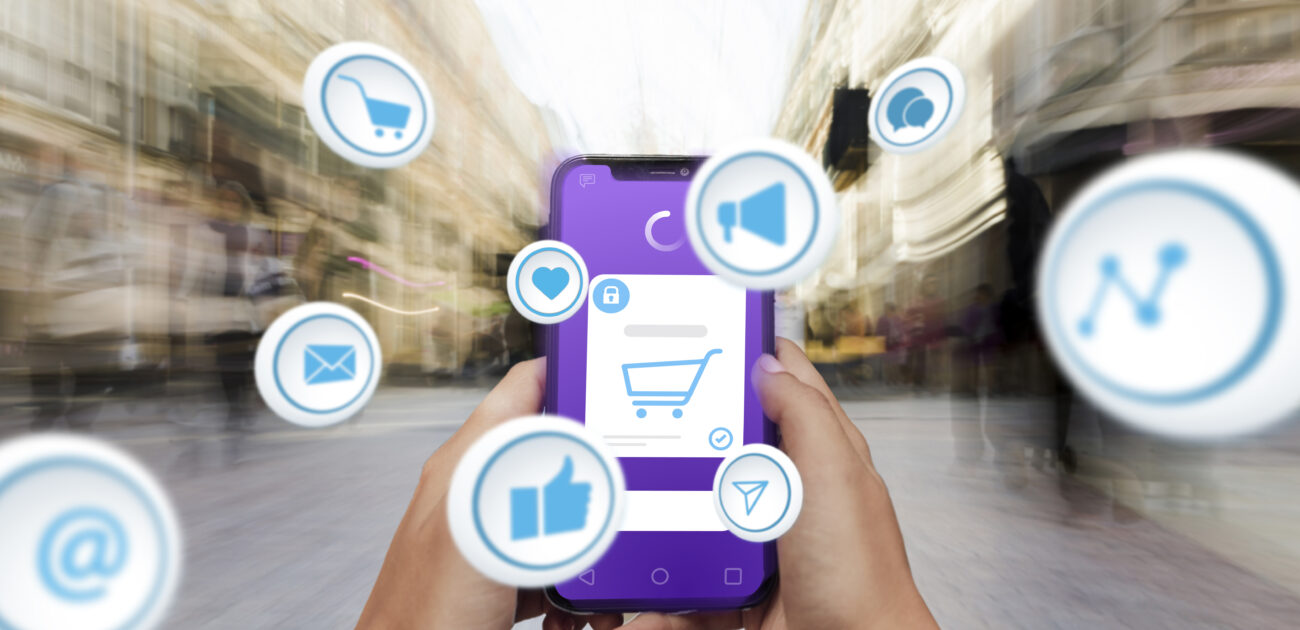The latest data from January 2024 shows that 93.2% of internet users aged 16 to 64 use social media, spending an average of 2 hours and 23 minutes daily browsing social networks. Combine this with the fact that social media represents the go-to source of pre-purchase information for 44% of Gen Z and 36% of Millennials, and you’ll quickly realize that e-commerce social media marketing is essential for growing your business in 2024.
But, successfully reaching, engaging, and converting your audience via social networks necessitates a strategic approach. More importantly, it requires understanding the latest trends, especially considering a super-short trend cycle and an even shorter audience attention span.
So, whether you want to up your e-commerce social media game or ensure you’re getting the basics right, here are the tips and best practices you must follow in 2024 and onwards.
1. Recommit to Follower Interaction
Social media can be an incredible platform for any business. However, the one mistake brands make is using social networks to talk at their audience instead of communicating with their followers.
Ultimately, if you think about it, the point of social media is to foster connection. And if you look at why people go on these platforms, you’ll discover that maintaining connection motivates most users. Moreover, research shows that:
- 79% of consumers favor brand messaging that develops a relationship.
- 83% of people care as much about how a brand treats them as they do about the quality of its products.
- 84% of consumers say online communities directly impact how they feel about a business and whether they buy from and remain loyal to said organization.
So, how can you use this to improve your social media marketing strategy? One of the best practices you should start implementing immediately is to recommit to follower interaction.
Ensure you’re focused on using social media to engage with your followers. Produce posts that will encourage your audience to reach out and connect. Use social listening tools to discover opportunities to forge new connections. Finally, do your best to make your social media communication genuine and human — especially as people are so aware that AI is replacing humans in customer care that they’re more likely to appreciate real interaction.
How you implement this strategy is entirely up to you (and should depend on your brand’s personality).
For instance, if you check out Duolingo on X, you’ll notice that the brand employs social listening to connect with its followers and uncover engaging content opportunities.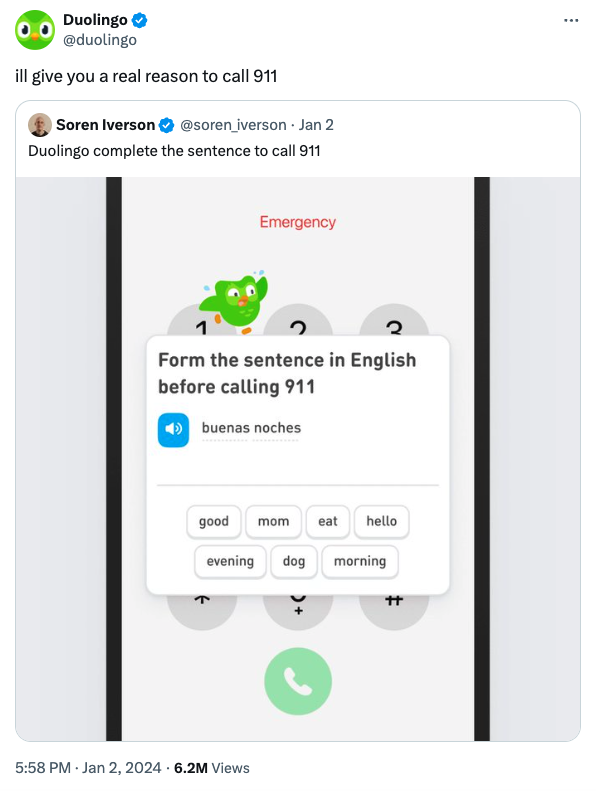
Source: twitter.com
However, as Golf Cart Tire Supply does, you can also employ this tactic to improve customer satisfaction. This brand is active on YouTube and uses the platform to present prospects with high-quality educational content.
But it also makes maximum use of the comment section below each of its how-to videos to answer customer questions and show its audience it cares about them getting the most out of their purchase.
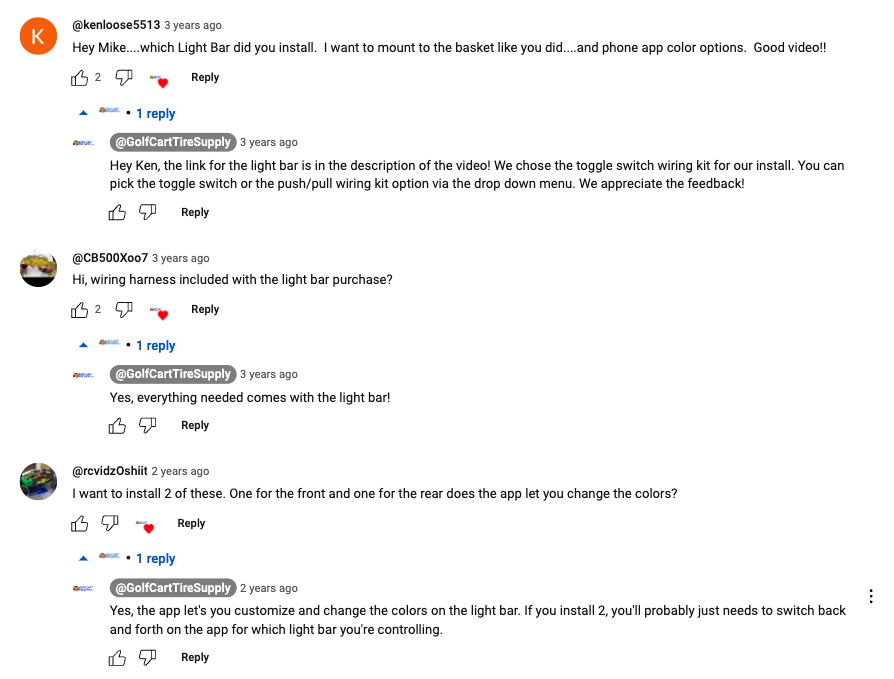
Source: youtube.com
2. Make Your Blog Content Links Pop with Video
There are many ways to elevate your e-commerce social media marketing strategy in 2024. But the one thing you must remember when tweaking your strategies is why you’re investing in socials in the first place.
Social media is an excellent platform for raising brand awareness and engaging your audience. But as an e-commerce brand, remember that your ultimate goal isn’t just capturing your target audience’s attention. Instead, to benefit from this type of marketing, you must invest your energy into converting leads into customers. One of the best ways to do this is to direct your followers to your website.
There are multiple ways to achieve this goal. Even something as basic as calling attention to a link in your bio — as Sherwin Williams does below — can be an excellent way to increase site traffic.

Source: instagram.com
Nonetheless, if you want to guarantee your posts stand out from the noise and genuinely capture your audience’s attention, you must use more engaging formats.
For instance, if you want your blog content links to pop, use video to introduce these articles. After all, the format was rated as the most effective type of content by 45% of marketers in Semrush’s latest State of Content Marketing Survey. So, it’s no surprise that brands that want to stand out, like Vivion, use short-form video clips to ensure their blog links stand out in a sea of similar posts.

Source: linkedin.com
3. Integrate Social Media Landing Pages for Instagram
If you employ Instagram in your social media marketing strategy, you already know the platform has much to offer. For starters, it has more than 2 billion monthly active users. It’s an exceptionally effective traffic generation tool due to the versatility of formats it supports, its interactive functionalities, and its potential for maximizing your reach.
However, Instagram can have one drawback that’s particularly impactful for e-commerce businesses. Given the app’s user interface design, the amount of real estate it offers for displaying bio content is extremely limited.
As a result, your profile visitors won’t always see the entire range of product page links you want to promote. This inconvenience is compounded by the fact that Instagram famously doesn’t allow links in post captions.
This combination of factors means that your account doesn’t have the power to direct web traffic to specific landing pages, reducing your ability to tailor your prospects’ shopping experience based on their position in the buyer’s journey.
Luckily, there’s an effective hack for removing this conversion obstacle. All you need to do is integrate social media landing pages with tools such as Linktree, Linkin.bio, Taplink, or Shorby.
For example, check out the Moto Machines Instagram profile. This brand utilizes a Linktree landing page to help its audience access the content/webpages relevant to their interest. By allowing followers to control their browsing journeys in this way, Moto Machines prevents high bounce rates on its website (which, in turn, benefits SEO). Plus, it actively shortens the sales cycle, ensuring prospects land on the content/product pages that correlate to what they intend to do.

Source: instagram.com
4. Repurpose Blog Content for Social Media
One of the downsides of primarily using social media to build brand awareness is that it necessitates a continually active posting schedule to see great results.
In 2024, the ideal posting frequency for all major platforms is higher than ever. For instance, TikTok recommends that brands post one to four times per day to see the best results. Yet, even if you align your schedule to the lower end of this number, you’ll find that pumping out that much new content demands an exorbitant amount of resources.
With this in mind, explore tactics to present your followers with new and engaging posts that will keep your business at the top of their minds. However, the trick is to do it without depleting your social marketing budget.
One of the easiest ways to overcome this challenge is to repurpose existing blog content for social media.
For example, if you check out Breaking Eighty, you’ll find that the business regularly publishes video versions of its most popular articles on YouTube. Considering that the platform is becoming one of the leading search engines for product research, this tactic makes perfect sense, allowing the brand to reach its audience in multiple ways without coming up with multiple content ideas per week.
The 8 Best Golf Shoes in Early 2024 (FOR EVERY BUDGET)
Source: youtube.com
5. Explore Lesser Used Social Media Platforms
Successfully employing social media marketing to grow your e-commerce business requires you to publish on the most popular platforms—Facebook, Instagram, YouTube, X, and TikTok. However, to elevate your game in 2024, you must look beyond those five social networks.
If you want to reach new prospects and outperform your competitors, explore smaller social media players. Smaller networks may allow you to grab your target audience’s attention more effectively. Or, they may even play an integral role in converting new customers.
For starters, if your e-commerce business sells physical products that embody a particular aesthetic, vibe, or aspirational lifestyle, Pinterest represents a marvelous opportunity to maximize reach and inspire conversions.
Check out Sokisahtel for an excellent example of how to make this network work for your business. Knowing that many of its products depend on seasonal interest, this brand created multiple themed Pinterest boards, uploading and tagging visuals to showcase products and ensuring that each post leads prospects to a related product page on its website.
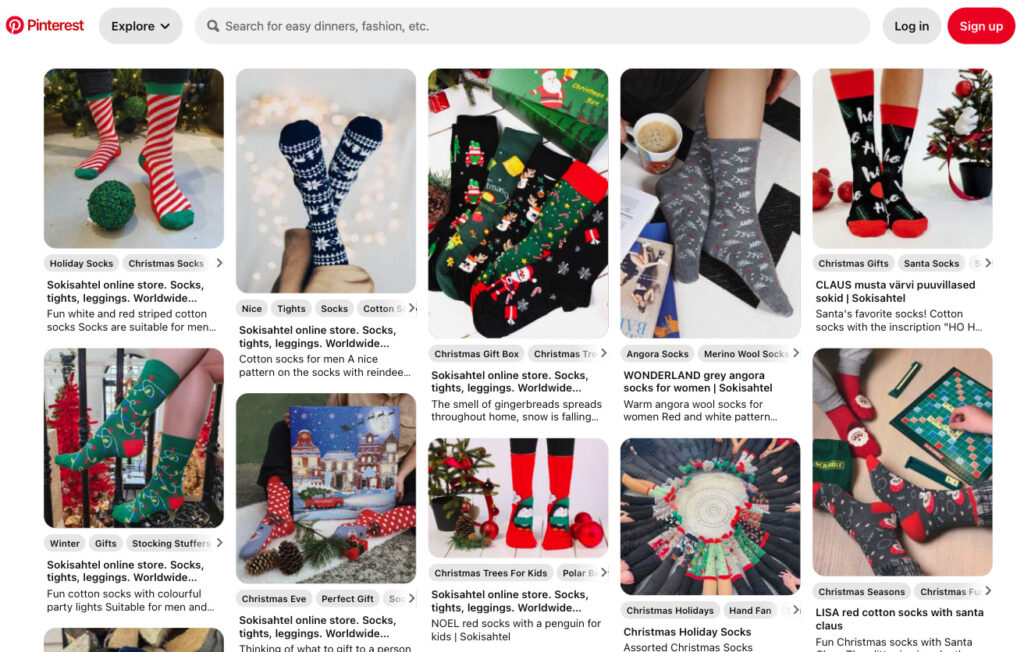
Source: pinterest.com
Or, if you want to employ social media marketing to build a community, why not add Reddit to your strategy? Reddit is the 8th-ranking website worldwide. It’s also an exceptional platform for sharing relevant news with your followers or even assisting customers in solving their issues.
Check out how Ikea does it on its IKEA Home Smart sub, where the brand posts everything related to its smart home product lines.
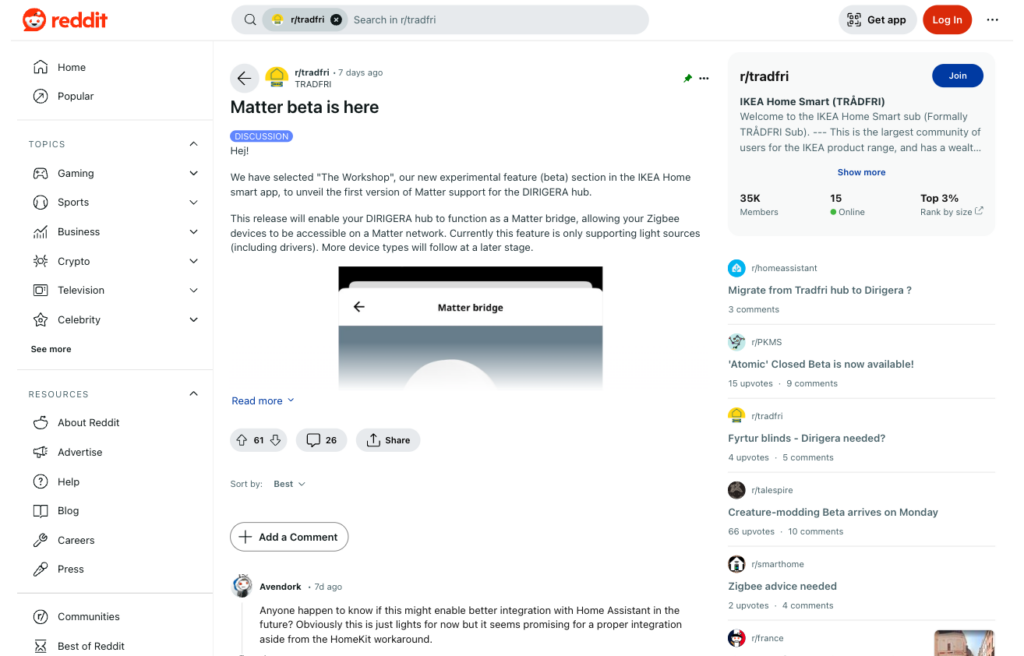
Source: reddit.com
Finally, if you’re prepared to take a more hands-on approach to product promotion and customer support, you could start playing around with Quora. Because this is a question-and-answer platform, it’s the perfect place to raise awareness about your products/brand and demonstrate competence in your niche, effectively maximizing brand trust.
Check out how the founder behind Waka Coffee uses Quora to educate potential buyers about coffeemaking. It’s an excellent strategy for growing an e-commerce business, and it’s not just because it introduces coffee lovers to a new product that could solve their pain points. Such answers benefit Quora users, improving their chances of getting an upvote and automatically enhancing the brand’s online visibility.
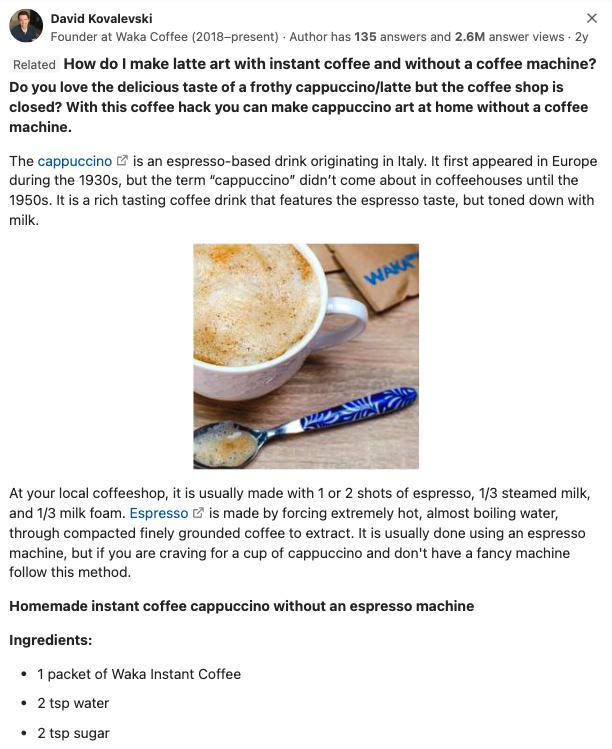
Source: quora.com
6. Implement Social Selling
Social selling is one of the social media trends you must embrace in 2024 — especially if you run an e-commerce business.
According to research, consumers don’t just find shopping inspiration on social networks. With the introduction of social selling functionalities, most platforms are becoming powerful sales channels.
In its State of Consumer Trends report, HubSpot revealed that 17% of people bought items directly from social media. And the practice is even more popular among younger generations, particularly Millennials (27%) and Gen Z (22%).
The best networks to implement social selling will be Instagram, Facebook, and TikTok. However, in addition to creating a shop for your brand, do your best to actively tag any products in your posts. That way, you can capture your followers’ attention and use their tendency toward impulse shopping to turn them into customers.
For an excellent example of how you can do this, check out Foreo on Instagram. Understanding the popularity of skincare-related content on the platform, this brand decided to up its marketing game on this social media channel. However, in addition to presenting followers with high-quality, engaging, and educational content, Foreo also allowed in-app shopping. This effectively shortened the sales cycle and improved its customer acquisition process.
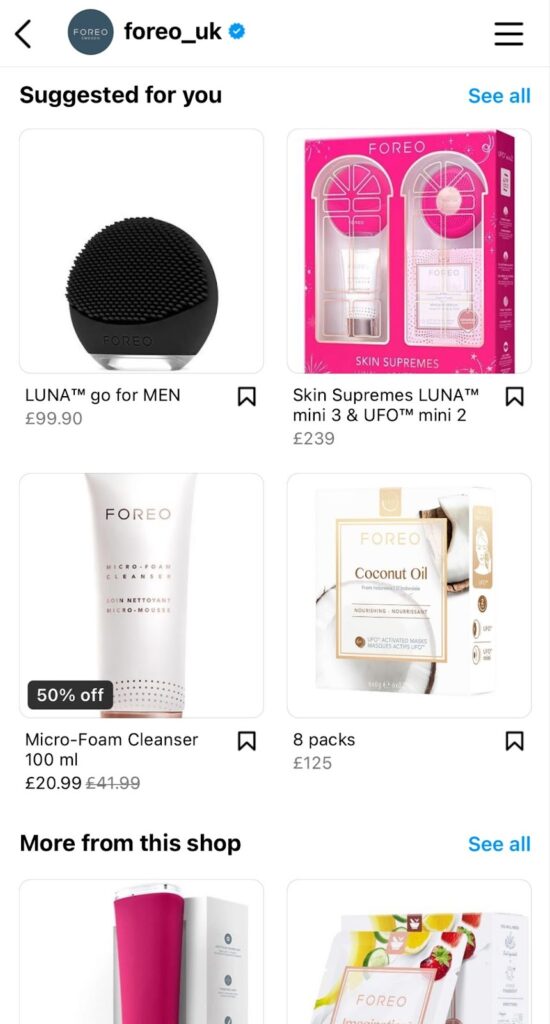
Source: instagram.com
7. Embrace TikTok
Another best practice for 2024 — especially if your business targets a younger audience — is to embrace TikTok.
Even though producing short-form videos for this platform may require you to widen your repertoire of content formats, the investment is guaranteed to pay off. TikTok saw an impressive 16% growth in user numbers last year, and it works wonders for e-commerce. It enables brands to bridge trust gaps, shorten sales cycles, and build communities all through the same app.
Naturally, if you decide to incorporate TikTok in your marketing strategy, explore ways to do so in the best possible way for your brand. Consider your social media goals and create content that aligns with the outcomes you want to reach.
For instance, check out how Fenty Beauty approaches the content creation for this network. Instead of only posting promotional videos and memes, this beauty brand enriches its content strategy with educational videos. By collaborating with make-up artists, it posts easy tips and tricks for end users to try with their Fenty products.
Such a social strategy results in more than just a large selection of videos that inspire purchases. More importantly, this content improves the customer experience by teaching buyers how to get the most out of their purchases, effectively inspiring customer loyalty.
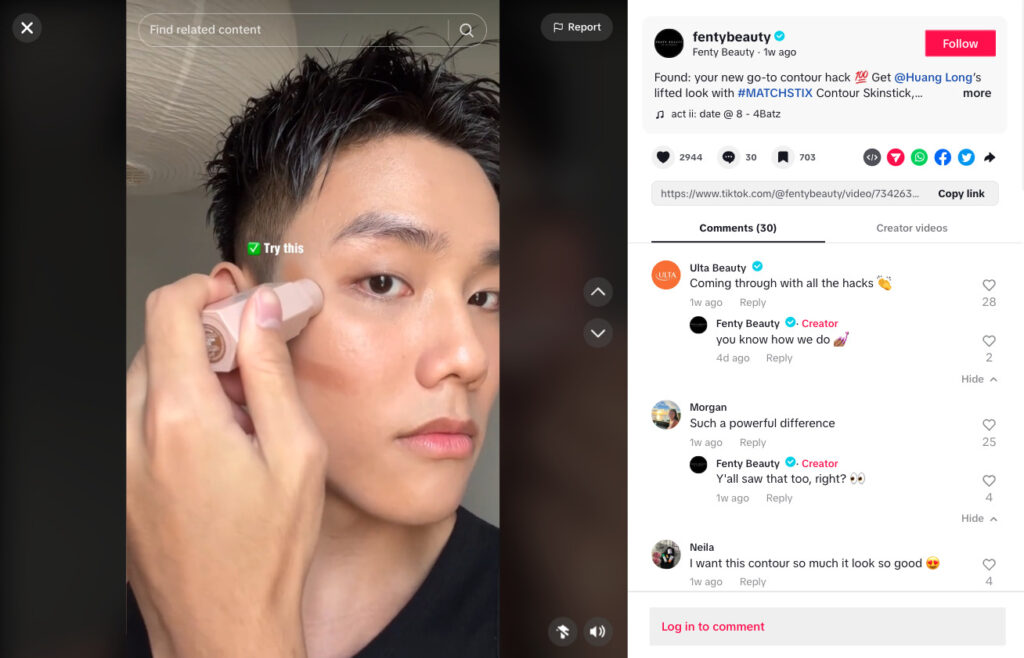
Source: tiktok.com
8. Partner with Expert Influencers
Another best practice to adhere to in your e-commerce social media marketing strategy in 2024 is to work with influencers.
Data from the latest State of Influencer Marketing Report shows that influencer-generated content outperforms brand-directed posts in engagement. But, perhaps even more importantly, collaborating with content creators can be an excellent way to boost conversions, especially considering that affiliate sales that leveraged influencers increased by 2,200% over the past year.
With this in mind, you may want to jump at the first opportunity to reach out to creators who could boost your reach or conversions. But remember that the best way to employ influencers is to do it with your brand’s personality and audience’s values in mind.
For example, the latest Edelman Trust Barometer Report demonstrates that proof — particularly scientific evidence — could be the key to earning consumer trust. So, going forward, approach the influencer selection process by prioritizing collaborator credibility and trustworthiness.
For one of the best examples of a brand investing in the ideal type of influencer content for its audience, check out Madden NFL. This brand organized a Pro Bowl series on Twitch, where professional NFL players competed with each other in a video game.
This is a brilliant content idea for the Madden NFL brand, not just because the pros create hype for the product. Seeing real-life football players interact with the video game is inspirational. It is powerful in convincing sports fans that they can get the same exciting experience by buying the game.
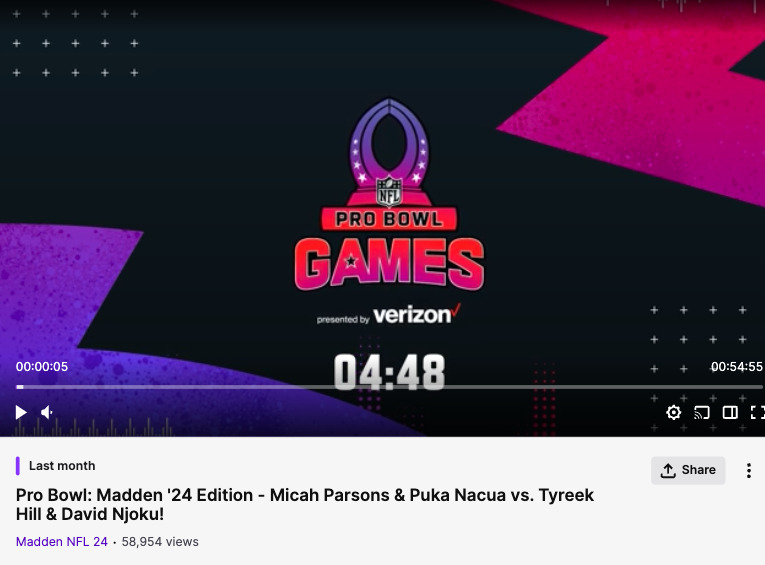
Source: twitch.tv
9. Don’t Forget UGC
Finally, as you explore ways to up your e-commerce social media marketing game in 2024, remember to prioritize authenticity when producing posts to distribute on social platforms.
Yes, branded, sales-oriented content can be enough to boost sales or even widen your reach. However, if you want your audience to fall in love with your brand (and choose it over your competitors), you must do your best to incorporate UGC into your feed.
Explore ways to source and showcase this format in your social media marketing. The easiest way will be to employ social listening and repost user-generated posts mentioning your products, as Thonet does below.

Source: instagram.com
Remember that user-generated posts aren’t just something you can use to fill in the gaps in your content production schedule. UGC can be a wonderful addition to your e-commerce website, regardless of whether you use it on your homepage, product pages, or even your site’s blog.
Final Thoughts
There you have it: the top e-commerce social media marketing tips and best practices for 2024.
Hopefully, you’re already employing most of these methods in your strategy. However, if you see that you’re missing a step or recognize that you could elevate your game to better align with current tendencies, do your best not to delay.
Social media trends come and go. Staying relevant on most channels requires an agile approach and a commitment to continuous improvement. So, be bold about trying new formats.
Explore novel platforms. Do your best to keep in touch with your audience so that you can reap the benefits of social media marketing without wasting your budget on content that doesn’t resonate with them or drive conversions.
Featured image by freepik.

